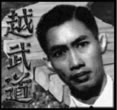Master Nguyễn Lọc
Master Nguyễn Lọc
Master Nguyễn Lộc became seriously ill. From 1957, his health was so bad that he had to stop teaching. He had to leave the teaching to his most advanced pupil, Master Lê Sáng, who helped him in his work and was responsible for the direction of the courses.
L’état de santé du maître fondateur s’aggrava encore plus, jusqu’au quatrième jour du quatrième mois du calendrier lunaire de 1960 où il décéda. Il avait à peine 48 ans et laissa une veuve et 9 orphelins (3 garçons et 6 filles).
He was buried in the Mạc Đỉnh Chi cemetery of Sàigòn. This cemetery would be destroyed in August 1983, and covered by new construction. The ashes of Master Nguyễn Lộc were carefully preserved in the Altar of Master Lê Sáng's Võ Đường, (Võ Đường Hùng Vương) at 30 Trần Hoàng Quân street (nowadays 31 Sư Vạn Hạnh Street), Sàigòn.
(This article is an adaptation from Patrick Levet's book Vovinam Viet Vo Dao Volume 1, 2006, World Expansion Office)
Born the 8th day of the 4th month of the lunar calendar of the year 1912, Master Nguyễn Lộc studied with assiduity the familial wrestling style, he did not remain satisfied with this legacy and traveled throughout the country, from the beginning of 1930, in search of the essence of a unified Vietnamese Võ Thuật (Martial Arts).
His purpose consisted in radically changing the concept of small schools or limited expansion styles, to transform it into the idea of large martial art diffusion, at national level at least. His conception of the martial art was the one of a whole set of techniques, above all efficient, even if they came from non Vietnamese martial arts (Japanese, Chinese, Western).
In 1938, Master Nguyễn Lộc synthesized his family style with the knowledge of the traditional schools that he studied and then, codified them into a teaching program. Nevertheless, the list of the styles he studied is unknown. The traditional wrestling (Vật), base of his original school, was a fundamental element of this synthesis.
When the war ended, in 1954, the Geneva Convention ordered the separation of Vietnam in two, with a government traced on the Soviet model in the North. A large number of the Northern people feared having the same fate as the Chinese people after the communists came to power in 1949. Together with millions of his compatriots, Master Nguyễn Lộc moved to the South along with most of his disciples



